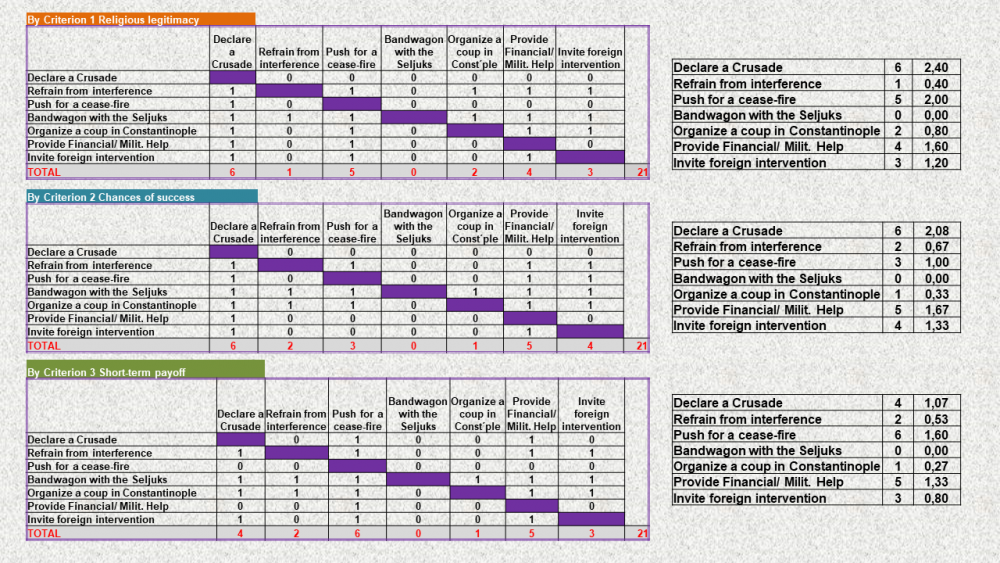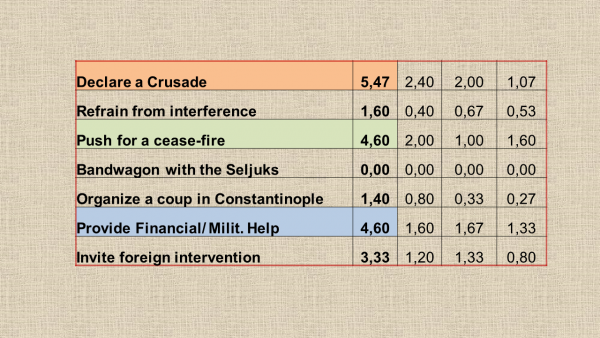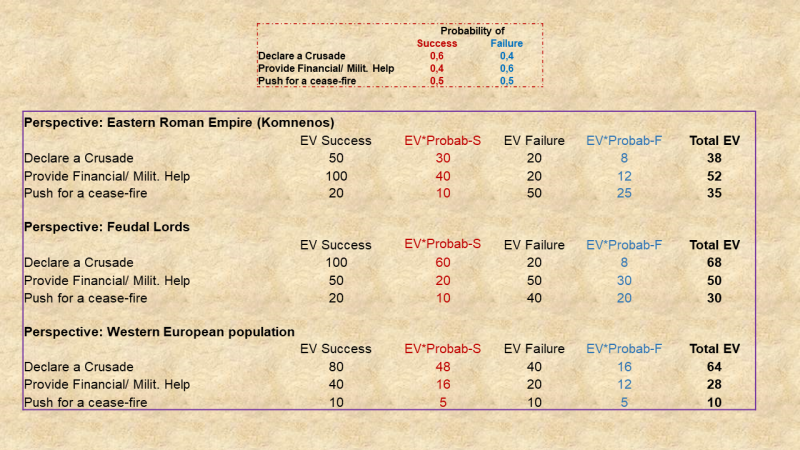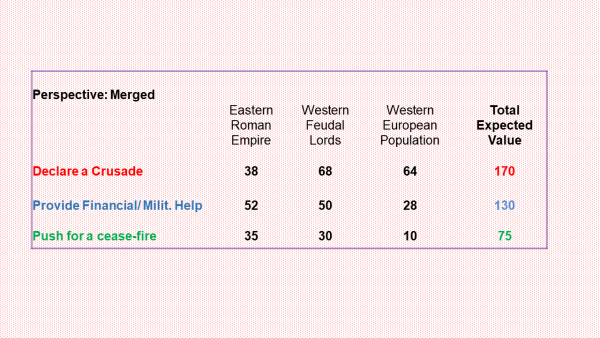The First Crusade – utility-based analysis as historical research method
This historical research method involves use of the Multiple-Perspective Utility Analysis (MPUA), a structured analytical technique. It is novel insofar it attempts an unorthodox – past- instead of future-driven – application of MPUA.
 Samuele Vasapollo is a scholar of history and international relations and can be contacted at: samuele.vasapollo – AT – gmail.com.
Samuele Vasapollo is a scholar of history and international relations and can be contacted at: samuele.vasapollo – AT – gmail.com.
This post is based on his thesis “GEOPOLITICS OF THE ANCIENT AND MEDIEVAL MIDDLE EAST: FROM THE FALL OF ROME TO THAT OF CONSTANTINOPLE”. He has obtained a Master´s degree in Middle Eastern Studies from the High School of Economics and International Relations of the Università Cattolica Del Sacro Cuore (Italy). Samuele is also co-founder of “Renovatio Imperii”, a cultural association devoted to the study of the Roman Empire’s political thought.
This case study postulates the First Crusade as a consequence of the 11th century international scenario characterized by the presence of two major World-Systems.
One being the Res Publica Christiana, composed by the Byzantine Empire, the Western European powers and the Papacy.
And the other one, Dar Al Islam, composed by a set of Muslim powers under the formal authority of the fragmented Abbasid Caliphate.
This analysis assumes that the concept of collective security is the primary driver of any political entity in any historical epoch. In consequence, this study looks at the Crusader military intervention in the Middle East as a deliberate action aimed at the containment of the Islamic/Seljuk powers along Roman frontiers.
The Byzantine Empire was long regarded as the Shield of Christ, and rightly so. Its stability was paramount for the collective security architecture of Western Europe.
These are the seven steps of MPUA included in our historic research method.
- Use divergent/convergent thinking to identify possible strategic options.
- Use weighted pair ranking to identify three options with the highest utility.
- Choose perspectives with a stake in policy options.
- Make a general assessment of the probabilities of success and failure for each of the three best options.
- For each of the perspectives, calculate total Expected Value of each option.
- Calculate the merged perspective.
- Seek input from the ultimate Decision taker/Tasking Authority.
Our objective of using MPUA is to shed new light on the roles of Pope Urban II, Alexios Komnenos, the Western Feudal Lords and the Western European population in the pre-war decision-making process.
Accordingly, we assume the ultimate decision taker to be Pope Urban II. And consequently, our MPUA will aim to maximize the Papacy’s/Western benefits from Constantinople’s struggle against the Seljuk military offensive.
Step 1. Use divergent/convergent thinking to identify possible strategic options.
The first phase in MPUA identifies a set of possible policy options. Each option leads to a different and pre-defined outcome. An option in itself has no utility to a decision taker. But each option is linked to an outcome that permits to realise benefits. And a particular outcome can be achieved only by selecting the corresponding option.
For the options to be as rational as possible, our choices have been deduced from the 11th century historical context. They focus on a range of possible strategies we assume were realistically available to the Pope.
- Declare a Crusade. Setting aside its religious background, this option simply stands for a joint, targeted Western military intervention in the Middle East aimed at freeing Constantinople from the Seljuk pressure.
- Refrain from intervention. This option stands for hypothetical Western inaction or hesitancy in response to Constantinople’s request for help.
- Aim for a cease-fire. Constantinople’s crisis began in 1071. Seljuk Turks flooded Anatolia after annihilating the Byzantine army in the battle of Manzikert. In the aftermath of that battle, the Seljuk Sultan Arp Arslan made arrangements with Romanos IV, the Byzantine Emperor whom he had made prisoner. The agreement provided for the surrender of some Byzantine settlements in eastern Anatolia in exchange for Emperor´s freedom. However, a coup in Constantinople deposed Romanos IV. And on his way back to Constantinople he eventually died through some Byzantine hands.
The coup d’état annulled the agreement between late Romanos IV and Alp Arslan. It suggests nevertheless that the Seljuks were not particularly interested in the occupation of the whole of Anatolia. It can therefore be inferred that in the period preceding the First Crusade the Seljuks could settle for a peace treaty in exchange for tributes and territorial concessions. This option, therefore, postulates the possibility that the Papacy could push for a peaceful resolution of the Byzantine-Turkish war.
- Bandwagon with the Seljuk Turks. The least plausible option among those present, true. But still a possibility. It would be an outcome of the Western betrayal of Constantinople in favour of Seljuk invaders.
- Stage a Coup in Constantinople. This option would aim at establishing a more direct control of the “Eastern approaches” by Western interests. In our view, this option is not quite as impossible as it may seem. Consider the events of the Fourth Crusade and the multiple power shifts in the Byzantine capital.
- Provide Financial and Military help. This option stands for supporting Constantinople by supplying money and mercenaries. The viability of this option is reinforced by the fact that initially Alexios Komnenos was not interested in a direct intervention of the Western European powers on Byzantine soil. Instead, he had requested soldiers (mercenaries) and resources.
- Invite Foreign Interventions. This option would mean the Papacy’s call for non-Western military interventions in support of Constantinople. We have knowledge that Western Europe had contacts with Central Asian populations and steppes’ tribes. These may well have been interested in joining the war in exchange for money, territory, and resources.
This option looks less likely than some of the others. However, it is validated by the European powers’ attempt to enter into an alliance with the Mongols before the outbreak of the Seventh Crusade. The religious affiliation of many Mongols (which were not yet a power in the 11th century) to Nestorian Christianity had allowed some talks between the two sides.
Step 2. Use weighted pair ranking to identify three options with the highest utility.
Weighted pair ranking represents a key step in the use of MPUA as a historical research method.
Task 2.1. Use divergent/convergent thinking to identify seven possible criteria.
The first task related to this step involves choosing a set of criteria for weighted ranking. A criterion reflects a core feature, aspect or characteristic of the type or category of options we are ranking.
- Cost. The economic commitment connected with each of the chosen options. Some policy choices may be more costly than others. Cost factor may reduce the appeal of an option.
- Religious legitimacy. It is a core aspect of the Western medieval international relations. The Papacy mediated them and legitimized by its religious authority.
- Short-term payoff. Immediate or prompt benefits expected from an option.
- Chances of success. This criterion refers to an option´s viability deduced from the contemporary understanding of the Christian/Muslim balance of power.
- Economic utility. The expected economic benefit arising from an option. Although a secondary aspect in the First Crusade, the economic return generated by the reconquest of commercial hubs held in Islamic hands – specifically in South Eastern Mediterranean – played its role.
- Long-term benefits. Those benefits that are expected to be realised in the longer term or over a longer period of time.
- Complexity to execute. The expected organisational/logistical complexity to execute an option.
Task 2.2. Conduct pair ranking to identify three top-ranking criteria.
This task involves ranking each criterion identified above against every other one, in pairs. “Chances of Success” takes the top rank. The runner-up option is “Religious Legitimacy” followed by “Short-term payoff”.
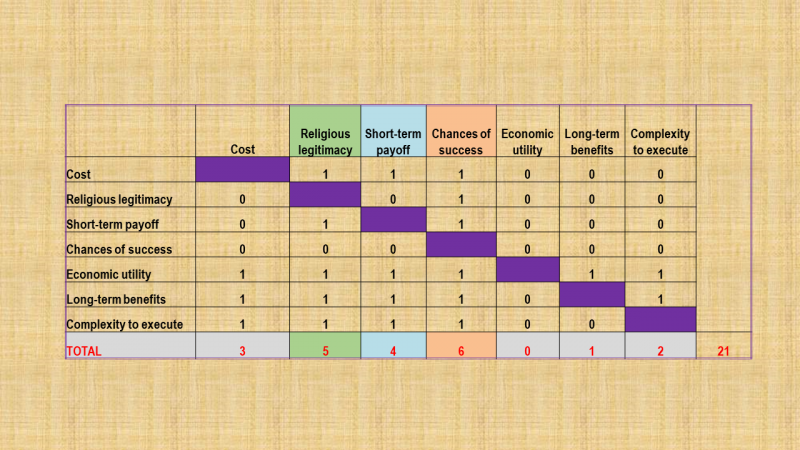
The application of MPUA as part of a historic research method prevents the researcher’s mind from unduly influencing the analytical outcome and increases the latter’s probity. As a consequnece, the ranking result offers a balance between realistic and idealistic policy drivers.
Next, we weigh the three top-ranked criteria.
- Chances of success (6) → 6/15 = 0,400
- Religious legitimacy (5) → 5/15 = 0,333
- Short-term payoff (4) → 4/15 = 0,267
Task 2.3. Conduct weighted pair ranking using the best-ranked criteria.
This last task finalises the selection of policy options that will form the core element of MPUA. It involves conducting three pair rankings of the seven options. For each run, we use the focus of one of the three top criteria selected before. It serves to look at the option through different “lenses” and thus increase the granularity of our judgement.
When it comes to the criterion “Chances of success”, the use of force to solve international conflicts is likely to appear an attractive choice. This case seems to be no exception.
International relations during the Middle Ages were predicated on the use of military solutions to achieve political objectives. The option “Declare a crusade” linked to a direct military intervention takes the first position. Another power option, “Provide Financial/Military Help”, ranks a close second.
When it comes to the criterion “Religious legitimacy”, the option “Declare a Crusade” once again does not leave any chance to the other ones. No surprise here.
The 11th century’s Papacy was honestly concerned with the weakening position of the Byzantine Empire. But there is no doubt that exerting Rome’s influence over its Western allies (most prominently the Frankish Kingdom and the Sacred Roman Empire) constituted a priority in Pope Urban’s political agenda. Rome’s commitment towards the reunification of the Western powers under the Cross was motivated by the necessity to heal the fracture with the Sacred Roman Empire. The latter had recently contended the Papacy’s primacy during the age of the investiture controversy (1076-1122).
Ranking by the last remaining criterion “Short-term payoff” favours a solution that allows to gain time.
The option “Push for a cease-fire” ranks at the top. Sticking with this option would allow the Papacy to avoid a military commitment. Benefits realised from reaping the peace dividend would be further enhanced by avoiding the costs of a military intervention. True, a cease-fire might probably not last long. Nevertheless, it would give Constantinople and the Western powers some precious momentum by lowering the international tension.
The weighted pair ranking step of MPUA is complete. It is now possible to add up all weighted values to determine the ranking of the seven options.
“Declare a Crusade” comes out clearly at the top. But there are two options in the second rank – and they have ended up in a perfect tie with 4,600000… points each.
[This is an extremely rare result. I would say, a mathematical oddity. 126 data points adjusted by three variables…and a perfect tie. Amazing, just absolutely amazing! – Edit.]
Step 3. Choose perspectives with a stake in policy options.
Perspectives reflect views of stakeholders to the choice of option with the highest utility. Given the unorthodox application of MPUA we attempt, this step is a challenging one. One characteristic of MPUA is a clear definition of perspectives. They need to be narrowed down to individuals as leaders representing compact interest groups.
In view of the temporal distance separating us from the analysed event, identifying specific individuals with a stake in the 11th century international scenario is hardly possible.
Instead, we tried to identify reasonable proxies by studying original sources and historical references that describe the First Crusade. Accordingly, we have chosen the following three perspectives.
- Eastern Roman Emperor Alexios Komnenos.
- The Western powers – among the others, Kingdom of France, Republic of Genoa and Italo-Norman Principalities.
- Western European peoples, who tended to see the military intervention as an opportunity for social redemption.
[While reviewing the manuscript for publication, I made the following observation to the author.
Inclusion of Western European peoples among stakeholders is questionable. MPUA is directed towards serving the needs of the decision taker (DETAK). Even in modern democracies, while popular interests and stakes are reflected in voting that´s about the limit of their influence on political decision-taking.
At the time of the First Crusade, I doubt that Western European peoples had any role in politics beyond serving as cannon fodder. Which means that their views on the comparative utility of different policy option were most likely irrelevant for DETAK.
True, Western European peoples were deeply indoctrinated in the righteousness of a religious confrontation and thus eager to take part in it when it was declared. But that does not have to imply that DETAK had to factor popular spiritual and religious eagerness into his own utility calculations.
In response, the author offered the following arguments.
“Concerning the “Western European peoples”, the topic is more complex than it may look. True, 11th-century population did not have any importance taken as individuals. However, we can affirm quite confidently that the Christian Western masses played a role of paramount importance in the unfolding of the First Crusade. It is not by chance that historians do not define crusades as simple wars. Rather, they regard them as a “phenomenon” that had been escalating since the 8th century AD.
By that time, Muslim fleets were raiding the coasts of the northern Mediterranean. Their attacks transformed the once-mighty Roman heartland into a no-man’s land. The crusading phenomenon whereby civilians started taking “the Cross” and autonomously engaging in combat with the Muslim invaders was quite common at that time.
One year before Urban II declared the crusade, in 1095, some 40.000 common people led by autonomous knights and priests gathered in central Europe and marched to Anatolia to fight the “infidels”. Many of them were poor and desinherited people desperately looking for personal fortune. Others were indoctrinated Christians who thought the Holy Spirit would truly help them once they entered territories under Islamic control.
They reached Constantinople and crossed the Bosporus. Upon entering the Anatolian heartland controlled by the Seljuk Turks, most were slaughtered and wiped out within few weeks.
So, we can rightfully state that Urban II did not invent a new modality of warfare in 1096. He rather institutionalized and put under his banners an already existing wave of armed resistance against the Muslims. Urban II “heard the winds of change” and took advantage of the popular mind-frame. Accordingly, several historians described the crusades through constructivist theories of sociology and international relations, emphasizing the “collective mentality” of the 11th century.” – Edit.]
Step 4. Make a general assessment of the probabilities of success and failure for each of the three top-ranked options.
The estimation of success/failure probabilities of each option should not be either arbitrary or intuitive. A historic research method should aim to avoid uninformed judgements. Instead, the probability valuation process should be based on a keen and accurate knowledge of circumstances and conditions prevailing at the time.
The 7th century Byzantine crisis broke the geopolitical unity of the Mediterranean. It opened the gates for Muslim assaults. About a century before the beginning of the Arab invasions, the Islamic Caliphate stretched from the Iberian Peninsula to the Indian subcontinent. The Eastern Roman Empire was in the phase of retrenchment. Western Christianity was reduced to a set of small and medium powers struggling for survival against the constant assaults, from land and sea, of the new-born Islamic empire.
However, by the 8th century A.D. the Abbasid Caliphate had eventually entered a period of decline and imperial disintegration. It prompted the Byzantine Empire to attempt to gradually recover some of its former territories.
The power balance between Constantinople and the Islamic polities shifted again in favour of the latter by the middle of the 11th century. The Seljuk Turks had started raiding Anatolia and penetrating Byzantine heartland. The disgrace of Manzikert (1071) had put the final nail in the coffin by endangering Constantinople’s very survival.
When the Byzantine Basileus Alexios Komnenos asked Pope Urban II for military help against the Seljuks, the Papacy’s objectives were twofold.
- Avoid by all means the collapse of the only deterrent against the Islamic penetration of Western Europe.
- Take advantage of the Byzantine Empire’s crisis to promote a unitary policy towards the Islamic threat, renewing the Papacy´s claim as the hub of Christian affairs.
In the light of the above, we shall now consider the comparative utility of the three best-ranked options for fulfilling the Papacy’s two primary concerns described above.
The option “Declare a Crusade” stands for a Western military intervention in the Middle East.
The Council of Clermont (1095) proved that a military intervention under the Papal banner perfectly fit Urban’s strategic agenda infused with both geopolitical aims and personal ambitions.
However, the outcome of an eventual military expedition remained quite uncertain. Consider the heterogeneous composition of the Crusader armies. Consider their fragmented command structure. Accordingly, we assign a moderately high success probability to this option, 60/40.
On the other hand, supplying the Byzantine Empire with mercenaries and financial resources – “Provide Financial/Military help” option – might look like a reasonable alternative.
By doing so, the Papacy and the Western powers could assure their collective security. And at the same time, avoid a potentially risky military expedition. However, the stability of the Eastern Roman Empire was not the only element at stake. The First Crusade’s sacred cloak hid both political and religious ambitions.
We assume the Papacy’s objectives focused both on collective security concerns AND its reassertion as the sole and only Christian authority (Investiture controversy + Eastern Schism). According to this inference, the Financial\Military support wouldn´t offer a high probability of success in achieving BOTH of the Papacy´s objectives.
At best, it would allow Urban to realise only one of his two top priorities. Hence, we assign a 40/60 success/failure split. Albeit viable, this option won´t result in full political-religious success.
Finally, “Pushing for a Cease-fire” option might have realistically appeared among the range of alternatives available to the Pope.
But it would have only put on ice the dilemma caused by Constantinople’s decline. A cease-fire wouldn´t have responded to the pressing necessity to repel the Seljuk threat. Nor would it have helped Rome to reclaim its authority over its allies. A central issue here is the disruption of the Papacy’s ties with the Sacred Roman Empire.
However, we want to maintain a sufficient degree of neutrality towards the possible outcomes of a Byzantine-Seljuk agreement. Such stance could help mitigate cognitive biases triggered by our limited knowledge of the events, which is a key requirement of a historical research method. Hence, we assign a 50/50 success/failure utility to this option. It could have equally proved a successful or an unsuccessful strategy.
Step 5. For each of the perspectives, calculate the Total Expected Value of each option.
The Byzantine Empire’s priority was to receive military, economic and logistical support from Western Christianity.
With Constantinople’s very survival at stake, the form of such support came second. Thus, Alexios Komnenos would gain some utility from the success of any option. At the same time, indirect military support (mercenaries/resources) would be by far the preferred option. It would not let foreign armies march on Byzantine soil.
A Western military intervention (Declare a Crusade) would bring some benefits as well. However, its utility will be offset by Constantinople’s mistrust towards Western European powers.
Regarding the option of a cease-fire, under the circumstances it would hardly be Constantinople’s preference. However, a balanced agreement between the two sides (such as that offered to Romanos IV by Arp Arslan) could favour the weaker side in the conflict. Which was the Byzantine Empire.
Regarding failure outcomes of different options, a failure always has at least some utility. Besides, a failure outcome can be viewed as a trigger. It could initiate the unfolding of a more favourable scenario. In Constantinople’s reasoning, the failure of a peace agreement might have pushed its Western allies to reconsider a military intervention. Or financial and indirect military support.
As for the Western powers’ primary objectives, there were principally two.
- Guaranteeing their national security, in the first place.
- And secondly, taking advantage of the bellum iustum to project their power abroad.
This is widely proven by the establishment of a number of Western states in the Levant in the aftermath of the First Crusade. The only option responding to both concerns is represented by the direct military intervention, which has thus the highest expected utility.
On the other hand, providing Constantinople with financial and military aid would only help achieve the first of the above two objectives. It wouldn´t have allowed Western European powers to physically enter the geopolitical arena of the Middle East. Nevertheless, this option would still maintain an acceptable degree of utility.
Last, the option “Cease-fire” would toally deprive the Western powers of their say in the “Eastern question”. Consequently, it receives the lowest expected utility value.
The Western European peoples´ perspective requires a bit of explanation.
The feeling of collective religious belonging played a major role in the development of the political discourse prior to the outbreak of the First Crusade. The concepts of spiritual redemption and religious pilgrimage were all central in shaping the socio-cultural premises of the Medieval epoch.
They contributed to the spreading of the “Crusader feeling” through all Christian social classes.
Along with the Byzantine decline, the Seljuk closure of Jerusalem’s holy places also had a great impact on the Christian collective mentality. It sharpened the feelings of spiritual duty and religious belonging. These were all infused with the idea that it was necessary to free the Holy Land from the Muslim yoke.
In this regard, the phenomenon of “popular crusades” sets a historic precedent.
They endorsed a number of massive, voluntary pilgrimages-cum-military expeditions to the Holy Land before the Pope’s official call for a military intervention. The so-called “Paupers’ Crusade” was the first and largest expedition of this kind.
It began in April 1096, when some 40.000 peasants and low-ranking knights set off from England, Lorraine, France and Flanders. They were determined to reach Jerusalem passing through the lands controlled by the Seljuk. However, numerous pilgrims starved to death during their march across Europe. Most of the rest were slaughtered by the Turks on entering Anatolia.
Since “Pushing for a Cease-fire” would not respond to the necessity of liberating Jerusalem from Muslim control, it is awarded very low utility. On the other hand, both options implying the use of force against the Turks obtain higher expected value. Unsurprisingly, “Declare a Crusade” wins.
Step 6. Calculate the merged perspective.
The merged perspective is the first actionable product of MPUA as a historical research method. It provides researchers and analysts with a unique view of the terms of the equation under analysis. Precisely, it gives us sufficiently reliable indicators of the overall degree of utility expected by the choice of a given strategy. Be it in the context of foreign policy making or, as in this case, for purposes of historical research.
The merged perspective describes the comprehensive understanding of the three scenarios by all stakeholders put together, their group consensus. This last point is paramount when it comes to the application of problem-solving methodologies to international relations. As well as Big Data analysis and, ultimately, academic studies in general.
Our merged perspective clearly favours decisive military actions.
Sending an expeditionary force clearly prevails over a half-risk/half-benefit option of warring through proxies. Appeasement and procrastination by means of a delaying political solution (cease-fire) finds no takers.
Two aspects can be observed in the development of the MPUA process so far.
- The order of the three top-ranked options proved very resilient. Despite the varying views of the three stakeholders “involved” in the process of expected utility evaluation, the final ranking remained unchanged. “Declare a Crusade” opened the dances and “Push for a Cease-fire” completed the list. It means that the “actual” stakeholders did not affect at all the preceding evaluation made by a presumed analyst team. This is a positive aspect when it comes to the interaction between intelligence analysis experts (analysts, researchers) and policy makers (politicians et similia).
- The gap separating “Provide Financial\Military help” and “Push for a Cease-fire” has exponentially increased. At the end of Step 2, they were in a perfect tie with 0,000…% difference. In the merged perspective, “Push for a Cease-fire” was trailing the runner-up option by a whopping 73,3%.
This aspect is central to us. It shows how cognitive biases implicit in the mind-frames of the different participants in MPUA were mitigated by the structured approach of this historical research method.
The utility perception of a hypothetical Byzantine-Seljuk agreement is higher for the non-partisan unpolitical view of intelligence analysts. They are trained to focus on the interpretation of data rather than on political and ideological objectives.
On the other hand, stakeholders such as the ruling elites of the Frankish Kingdom, Papacy, Byzantine Empire and others would hardly heave the same attitude towards the latter.
Step 7. Seek input from the ultimate Decision taker/Tasking Authority.
MPUA is seldom conducted on analysts’ own initiative. Rather, it typically responds to the tasking by high-level stakeholders. Use of MPUA in the context of a historical research method will also reflect this hierarchy.
In our case, we assume the ultimate decision taker to be Pope Urban II. The decision taker will naturally have a stake in the benefits of the chosen option. And thus, a voice in the process of its selection. And it must be a very special kind of a voice.
The decision taker will not just offer another set of utility valuations like any of lower-level stakeholders. That would hardly ever significantly affect the merged perspective. Instead, the decision taker will have the authority to influence the merged perspective by weighting the three options under consideration.
Distribution of weights by the decision taker among the options will mostly reflect its assessment of utility vs. risk.
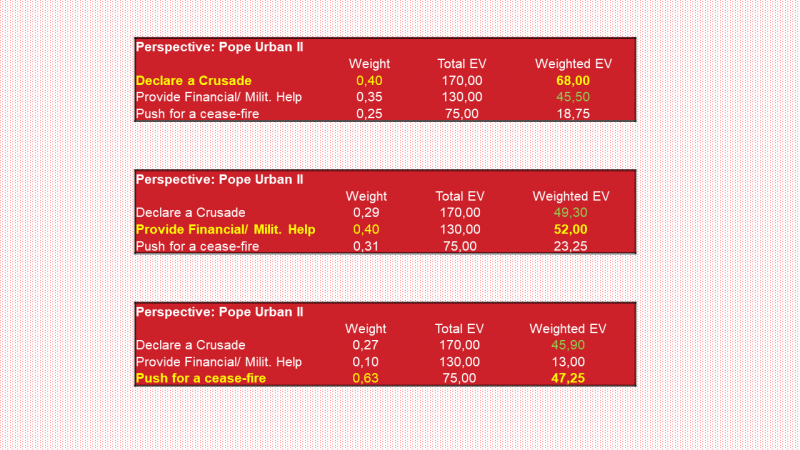
A decision taker may be inclined to go with the flow and favour the top-ranking option of the merged perspective. After all, it reflects the group´s preference and thus suggests the politically safest way forward.
The more weight is required to overturn the merged perspective, the stickier it will be. In our case, the decision taker could override the stakeholder consensus in favour of the runner-up option by only a mild switch in his preferences.
But in the case of the “soft” cease-fire option, that becomes as good as impossible. It will require assigning the weight of 0,63 that exceeds the rationality limit of 0,60.


